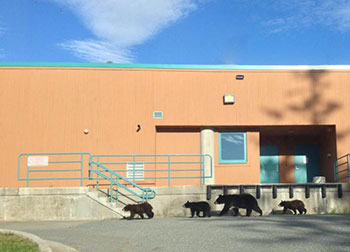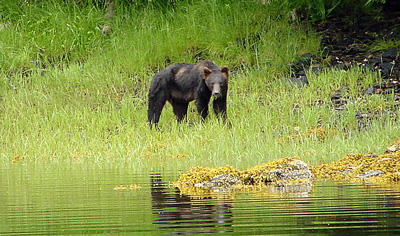Bear Safety
Excerpts from the State of Alaska, Department of Natural Resources, Division of Parks and Outdoor Recreation: The Essentials for Traveling in Bear Country .
UAS & Bears
 The UAS campuses and surrounding properties have been built on game trails. Bear, deer and other wildlife move through the same space we do. Wildlife encounters are rare, but possible. This Bear Safety section of the Guide provides general information from the State of Alaska, Department of Natural Resources.
The UAS campuses and surrounding properties have been built on game trails. Bear, deer and other wildlife move through the same space we do. Wildlife encounters are rare, but possible. This Bear Safety section of the Guide provides general information from the State of Alaska, Department of Natural Resources.
You are encouraged to be aware of your surroundings, travel with friends, and make noise as move through our bear country. It is permissible for students to carry bear spray on their person, on campus. Bear spray canisters must always be used in a responsible manner. Faculty members have the right to ask students to leave bear spray canisters outside of the classroom.
Never feed a bear. Feeding any wild game is dangerous and against the law. If you have concerns regarding bear activity on campus, please call Dan Garcia, UAS Safety Manager at 907-796-6077 or your local police.
Family of black bears crossing campus behind the Egan Library. Photo by Katy Jordan.
Bear Behavior
 One of the things that makes Alaska so special is that all three species of North American bears flourish here. There is a chance that you may be lucky enough to see a bear. But even if you don't, you will never be far from one, because Alaska is bear country.
One of the things that makes Alaska so special is that all three species of North American bears flourish here. There is a chance that you may be lucky enough to see a bear. But even if you don't, you will never be far from one, because Alaska is bear country.
Brown/grizzly bears are found from the islands of southeastern Alaska to the arctic. Black bears inhabit most of Alaska's forests. Polar bears frequent the pack ice and tundra of extreme northern and western Alaska.
Most bears tend to avoid people. In most cases, if you give a bear the opportunity to do the right thing, it will. Many bears live in Alaska and many people enjoy the outdoors, but surprisingly few people even see bears. Only a tiny percentage of those few are ever threatened by a bear.
Bears & People
Bears Don't Like Surprises!
If you are hiking through bear country, make your presence known — especially where the terrain or vegetation makes it hard to see. Make noise, sing, talk loudly or tie a bell to your pack. If possible, travel with a group. Groups are noisier and easier for bears to detect. Avoid thick brush. If you can't, try to walk with the wind at your back so your scent will warn bears of your presence. Contrary to popular belief, bears can see almost as well as people, but trust their noses much more than their eyes or ears. Always let bears know you are there.
Don't Crowd Bears!
Give bears plenty of room. Some bears are more tolerant than others, but every bear has a personal “space” — the distance within which a bear feels threatened. If you stray within that zone, a bear may react aggressively. When photographing bears, use long lenses; getting close for a great shot could put you inside the danger zone.
Bears Are Always Looking for Something to Eat!
Bears have only about six months to build up fat reserves for their long winter hibernation. Don't let them learn human food or garbage is an easy meal. It is both foolish and illegal to feed bears, either on purpose or by leaving food or garbage that attracts them.
Close Encounters: What to Do
If you see a bear, avoid it if you can. Give the bear every opportunity to avoid you. If you do encounter a bear at close distance, remain calm. Attacks are rare. Chances are, you are not in danger. Most bears are interested only in protecting food, cubs, or their “personal space.” Once the threat is removed, they will move on. Remember the following:
Identify Yourself
Let the bear know you are human. Talk to the bear in a normal voice. Wave your arms. Help the bear recognize you. If a bear cannot tell what you are, it may come closer or stand on its hind legs to get a better look or smell. A standing bear is usually curious, not threatening. You may try to back away slowly diagonally, but if the bear follows, stop and hold your ground.
Don't Run
You can't outrun a bear. They have been clocked at speeds up to 35 mph, and like dogs, they will chase fleeing animals. Bears often make bluff charges, sometimes to within 10 feet of their adversary, without making contact. Continue waving your arms and talking to the bear. If the bear gets too close, raise your voice and be more aggressive. Bang pots and pans. Use noisemakers. Never imitate bear sounds or make a high-pitched squeal.
If Attacked
If a bear actually makes contact, you have two choices: play dead or fight back. The best choice depends on whether the bear is reacting defensively or is seeking food. Play dead if you are attacked by a grizzly bear you have surprised, encountered on a carcass, or any female bear that seems to be protecting cubs. Lie flat on your stomach, or curl up in a ball with your hands behind your neck. Typically, a bear will break off its attack once it feels the threat has been eliminated. Remain motionless for as long as possible. If you move, and the bear sees or hears you, it may return and renew its attack. Rarely, lone black bears or grizzlies may perceive a person as potential food. Fight any bear that follows you or breaks into a tent or building. Fight any black bear regardless of circumstances.
Protection
Firearms should never be used as an alternative to common-sense approaches to bear encounters. If you are inexperienced with a firearm in emergency situations, you are more likely to be injured by a gun than a bear. It is illegal to carry firearms in some of Alaska's national parks, so check before you go.
State law allows a bear to be shot in self-defense if you did not provoke the attack and if there is no alternative. But the hide and skull must be salvaged and turned over to the authorities.
Defensive aerosol sprays which contain capsicum (red pepper extract) have been used with some success for protection against bears. These sprays may be effective at a range of 6-8 yards. If discharged upwind or in a vehicle, they can disable the user. Take appropriate precautions. If you carry a spray can, keep it handy and know how to use it.